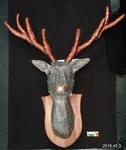
Corrugated iron cladding on the Cranmer Courts building.

A photograph of a colourful corrugate iron roof, located on the corner of Barbadoes Street and Worcester Street. Two iron green butterflies sit atop the roof, while a string of butterfly patterned flags hang from the gutter rails.

Palm tree standing in the grounds of The Pump House. In front is a bin of corrugated iron.

Emergency personnel using a sheet of corrugated plastic to slide pieces of rubble of the collapsed Canterbury Television Building.

The roof of a house on Canterbury Street in Lyttelton is patched up with mismatched sheets of corrugated iron.

Volunteers nail corrugated iron to the outside of the 10 square metre office building, soon to be Gap Filler Headquarters.

A photograph of Whole House Reuse item 224. This item was salvaged from 19 Admiral Way in New Brighton as part of the Whole House Reuse project.

A photograph of Whole House Reuse item 225. This item was salvaged from 19 Admiral Way in New Brighton as part of the Whole House Reuse project.

A thumbnail photograph of Whole House Reuse item 225, cropped for the catalogue. This item was salvaged from 19 Admiral Way in New Brighton as part of the Whole House Reuse project.

A thumbnail photograph of Whole House Reuse item 224, cropped for the catalogue. This item was salvaged from 19 Admiral Way in New Brighton as part of the Whole House Reuse project.

Volunteers drill holes in corrugated iron on the outside of the 10 square metre office building, soon to be Gap Filler Headquarters.

A pigeon perches in the beams of a damaged building. The photographer comments, "The building next door was demolished after the Christchurch earthquake, which exposed the side of this building with it's very old corrugated iron walls. Some of the sheeting was damaged and exposed parts of the interior. The pigeon was sitting on a bit of wood with the beam above it had a very serious crack. I think you would be nervous as well".

Poster starting to peel off a corrugated wall next to demolition site. A section of damaged property can be seen above the fence.

A photograph captioned by BeckerFraserPhotos, "An old painted corrugated iron wall which was uncovered during the demolition of 112 Manchester Street".

A photograph captioned by BeckerFraserPhotos, "An old painted corrugated iron wall which was uncovered during the demolition of 112 Manchester Street".

A photograph of street art on a corrugated-iron fence between Brighton Mall and Berefords Street. The artwork depicts the face of an elderly man.

Volunteers setting up one of the painted pianos on the site of a demolished building. The piano has a Perspex and corrugated iron roof over it.

One artwork in the shape of a stag's head, made from recycled copper and flattened corrugated iron. The item could be used as a coat hook.

Emergency personnel using a sheet of corrugated plastic to slide pieces of rubble from the collapsed Canterbury Television Building. Behind them, smoke is billowing from the remains of the building.

An old advertising sign exposed by the demolition of an adjoining building. The photographer comments, "'Protect your investment. Paint your property regularly - and save money. Polson's decorators and sign writers.' The building that was adjacent to this one was demolished after the Christchurch earthquake and revealed this fabulous old wall sign.

A photographs of the Fuze Restaurant & Cafe Building on London Street in Lyttelton. The top storey of the building has been deconstructed, and a new roof has been made with plywood and corrugated iron.

A photograph of a corrugated-iron clad building on Oxford Street, which is all that remains standing after the buildings around it have been demolished. The photograph is captioned by BeckerFraserPhotos, "13 Oxford Street in Lyttelton".

A photograph of a corrugated-iron clad building on Oxford Street, which is all that remains standing after the buildings around it have been demolished. The photograph is captioned by BeckerFraserPhotos, "13 Oxford Street in Lyttelton".

Emergency personnel sliding a metal beam down a sheet of corrugated plastic on the collapsed Canterbury Television Building. Smoke is billowing from the ruins, which were still partly on fire when the photograph was taken.

Plant beds made out of corrugated iron, greening the empty building sites along Colombo Street. These were placed here by Greening the Rubble, a community project in Christchurch to create temporary public parks and gardens on the sites of demolished buildings.

Construction workers examining the damaged top of the facade of the Lyttelton Coffee Company building on London Street in the basket from a crane. In the foreground, a pile of scrapped corrugated iron can be seen.

Construction workers examining the damaged top of the facade of the Lyttelton Coffee Company building on London Street in the basket from a crane. In the foreground, a pile of scrapped corrugated iron can be seen.

Smoke billowing from the remains of the collapsed Canterbury Television building on Madras Street. Below, emergency personnel are searching through the rubble for trapped people. A piece of corrugated plastic is being used to slide pieces of debris off the site.

Emergency personnel searching for people trapped in the collapsed Canterbury Television Building on Madras Street. Their efforts include using a piece of corrugated plastic as a slide to remove objects from the rubble. Smoke can be seen rising from the building.

Emergency personnel searching for people trapped in the collapsed Canterbury Television Building on Madras Street. On the right, a sheet of corrugated plastic is being used to slide pieces of debris off the building. Smoke is billowing from the ruins, which are still partly on fire.